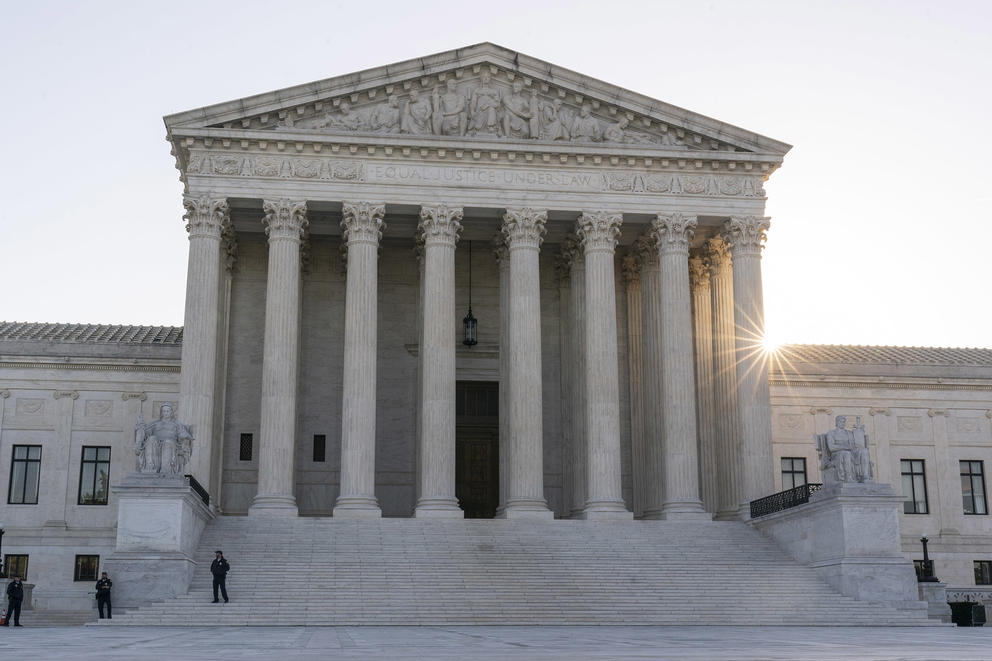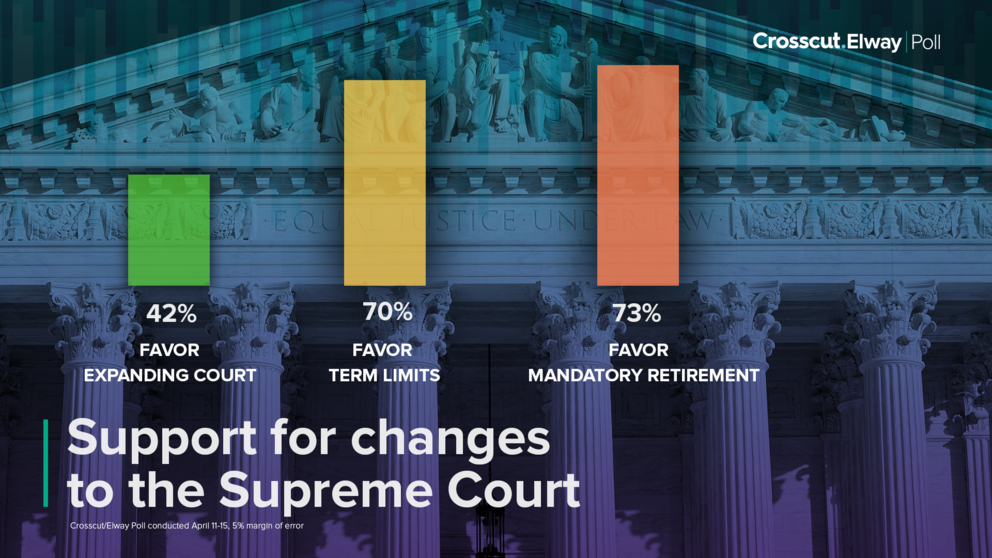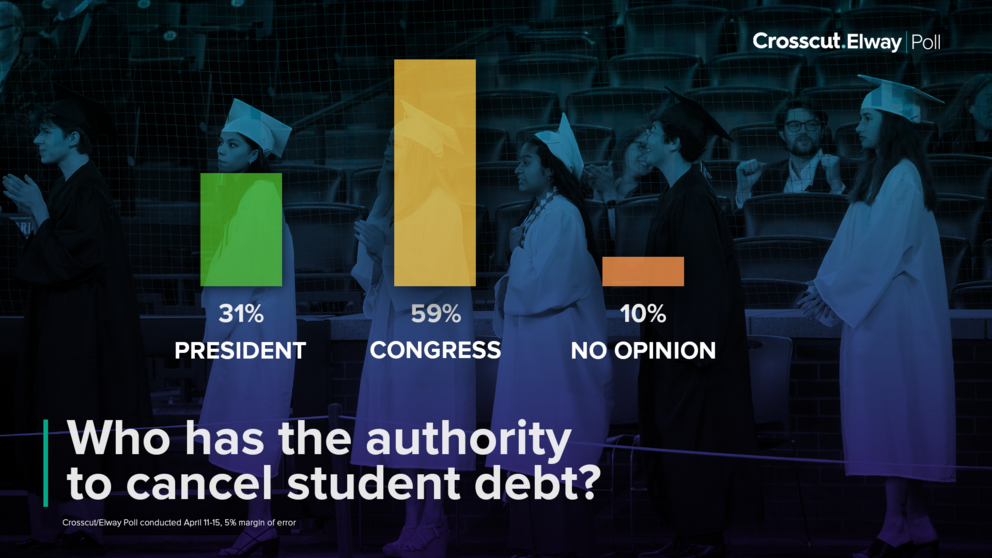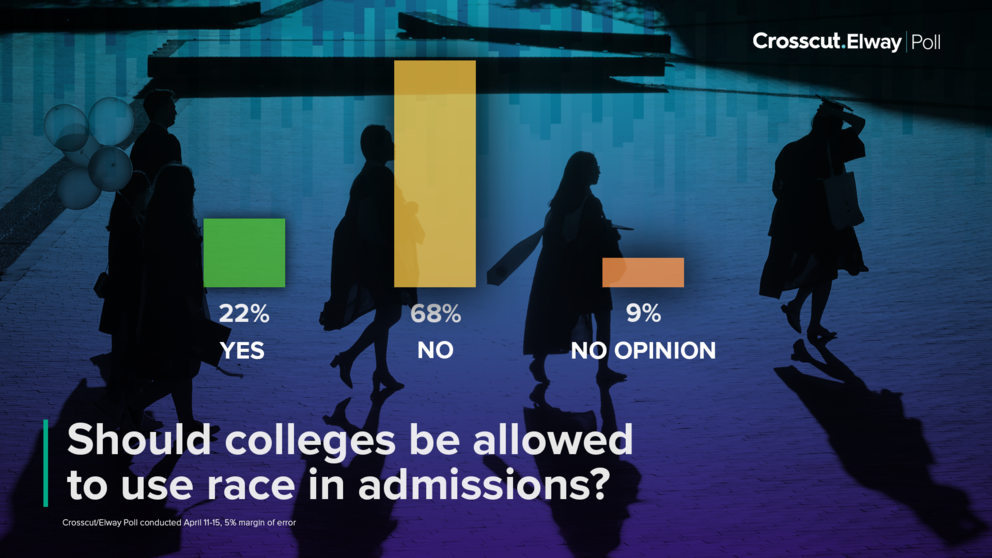Those results mirror two recent national polls that also show Court approval is waning.
And like other branches of the U.S. government, opinions on the judicial branch now fall more along partisan lines.
“I do think the Supreme Court’s long status as an institution that had a fair amount of approval on both sides will not be coming back,” Scott Lemieux, assistant teaching professor for the University of Washington’s political science department.
While overall figures are split — 46% of those polled statewide said they “disapprove” or “strongly disapprove” of the Court, and 45% responded that they “approve” or “strongly approve” — the numbers look very different when broken down by party.
Democrats, at 64%, were more likely to express disapproval of the U.S. Supreme Court, while Republicans at nearly the same percentage — 66% — were most likely to approve. The poll was conducted after ProPublica reported that Supreme Court Justice Clarence Thomas had failed to disclose gifts he received from a billionaire Republican donor, but it did not ask about that controversy.
Respondents’ party affiliation factored less in other questions about the Court, with support on both sides for reforming the institution, including 85% supporting at least one reform and most people supporting more than one reform. Democrats and Republicans also largely agreed on some key issues before the Court this year, including affirmative action, student loan debt and transgender girls' participation in school sports.
“There’s lots of appetite for reforming the Court,” said pollster Stuart Elway. “They’re split all over the place on the cases before the Court. It was a mixed bag of answers.”
Approval of Supreme Court tied to partisanship
The polarization of opinion around SCOTUS has been building in recent years, with conservatives mobilizing voters during the 2016 presidential election by focusing on the prospect of bringing more conservative justices to the Court, said Lemieux, the University of Washington professor.
Last June’s decision on abortion accelerated the view of the U.S. Supreme Court as a politically driven institution, especially among Democrats, he said.
Indeed, a majority of Washingtonians polled — 58% — believe that the U.S. Supreme Court now “follows a political agenda.” Only 33% said the Court “adheres to the Constitution.”
Nearly three-quarters of Democrats said the Court followed a political agenda, but even Republican respondents were split, with 44% on either side.
More than 400 registered voters were interviewed for the Crosscut/Elway poll conducted April 11-15, via cell phone and landline and with people invited via text message to participate in an online survey. The poll has a 5 percent margin of error with 95% confidence, which means if the same poll was conducted 100 times, we would expect to get the same results 95% of the time.
Poll participant Leslie Jackson, a 58-year-old Democrat from Lake Stevens, said the Court’s recent ruling to overturn Roe v. Wade clearly revealed a political agenda.
“There was no precedent that came up. The appointees of Trump planned on doing this before they were nominated and appointed,” she said. “It just seemed planned and premeditated.”
For Steve Ness, a 75-year-old from Shelton, it was “pretty obvious” that the Court was driven by “a political lens” rather than the U.S. Constitution.
Ness said that he had that feeling before the abortion ruling, but the ruling was the most obvious indicator of what he considered a move rightward.
“Part of the problem is it’s so heavily weighted toward the conservative side now,” said Ness, who considers himself Independent. “It’s just been a gradual shift. They can dictate outcomes. There’s not much of a debate.”
However, that same ruling was also why Vikash Prakash, a Republican from Camano Island, strongly approves of the Court. Prakash, 44, also said he felt the Court adhered to the Constitution.
“The [U.S.] Supreme Court has ruled correctly,” said Prakash, 44. “Born or unborn, every person is an American. Every person has a right to life, liberty and pursuit of happiness.”
While there has always been ideological division in the Court, there wasn’t always such a direct line between election choices and court appointments. Republicans appointed some of the more liberal justices in recent decades – Justice John Paul Stevens by President Gerald Ford and Justice David Souter by President George H.W. Bush. Further back in history, Democratic Presidents Truman, Roosevelt and Wilson appointed some conservative justices.
On the modern Court, all currently sitting liberal justices are Democrat appointees and conservatives are Republican appointees, Lemieux said.
Lemieux believes there will be more political clashes as long as a supermajority of conservatives are on the Court. This will be true whenever Democrats occupy the White House and Republicans dominate statehouses, he said.
“If Democrats were to become a dominant political coalition, the most likely outcome would be a constitutional crisis involving some kind of major judicial reform,” Lemieux said. “Although given rural/urban polarization, it’s hard to see Democrats having enough of a Senate majority to do this anytime soon.”
Overwhelming support for court reforms
When asked, most voters favored three of four potential court reforms: mandatory retirement, term limits, and establishing rotating 18-year terms so every president would nominate a new justice every two years. Increasing the number of justices on the court was less popular.
Nearly 73% of respondents favored a mandatory retirement age for Supreme Court justices.
For Ness, the Shelton resident, part of his support for mandatory retirement is driven by his own aging experience. “I still think my mind is still OK, but it definitely doesn’t have the sharpness it did at one time,” he said.
He believes that allowing Supreme Court justices to continue ruling into their final years could have dire consequences for the nation. “I don’t think their judgment has improved with age. They fall into a way of life that’s not protective for the American people,” he said.
Meanwhile, 70% supported term limits and 57% supported rotating terms.
“It just seems like the justices can get out of touch with what’s going on,” said Jackson of Lake Stevens. “An age limit or a maximum number of years seems appropriate.”
Adding more justices to the court received the least support of the four reforms: 49% of respondents opposed it and 42% favored it.
Ness felt adding justices would just lead to gamesmanship from whatever political party has control of Congress, he said.
Indeed, expanding the court can be done with simple legislation, while other reforms, such as term limits and mandatory retirement, would require a constitutional amendment, Lemieux said.
“More modest reforms are legally harder to pass,” he noted.
Opinions on cases before the Court
Poll responses were less likely to be along partisan lines when people were asked to express their opinions on the cases before the Court this year.
Just 2% of poll respondents agreed with either the progressive or conservative side on all eight cases highlighted in the poll. On average, respondents agreed with the progressive side in 3.7 of the eight cases versus 3.4 for the conservative side. And political party affiliation was not predictive in this part of the poll.
Elway said the responses indicate that while the hardcore base of each political party may have defined partisan views, most voters have less clean-cut opinions regarding individual issues.
“There is more fluidity among voters on some of these questions,” he said. “They’re picking their ways through these cases and treating them individually in large part.”
Regarding canceling college student debt, nearly twice as many residents — 59% vs. 31% — said it should require an act of Congress rather than a decision by the president. Democrats were the only demographic category with a plurality — 46% to 44% — who said the president has the authority to cancel student debt.
Ness, the Shelton Independent, said he was conflicted on this question because he had children who have benefited from government measures, such as the G.I. Bill, that helped pay for college. However, he felt it was “not a good thing” for the country to move toward giving more power to the president.
“I think that it’s better to have the power within Congress,” he said. “That said, we have such a dysfunctional Congress right now. That’s not really a good answer either.”
In the abstract, most would prefer procedural action — in this case, Congressional action over executive power to step in, Lemieux said. However, people could change their view if the actual ruling has a real-life impact — namely, if they or someone they know is saddled with student debt for a long period of time.
Affirmative action
Poll responders also overwhelmingly agreed that “Race should have no consideration in college admissions,” with 68% saying so compared to 22% saying it should be “one consideration.” In addition, majorities in every demographic category, including Democrats, stated colleges should not consider race in admissions.
Affirmative action, where race can be a factor in hiring or university admission, has been illegal in this state since 1998 with the passage of Initiative 200. More than two decades later, Referendum 88, which would have restored affirmative action, narrowly failed, despite language that would restrict quotas.
Former Gov. Gary Locke, who was in office when I-200 passed and voiced support for the passage of Referendum 88, said he had benefited from affirmative action policies. He said being a person of color, a West Coast resident and a student in public schools all featured in his college acceptance.
Locke, now interim president of Bellevue College, said affirmative action should be seen as a tool to recruit students of diverse ethnic and racial backgrounds, just as an admissions office would consider a variety of academic, community and life experiences when deciding which students to accept.
While colleges and universities have found ways compliant with current laws to recruit students with diverse backgrounds, officials say it’s much more challenging without being able to explicitly consider racial backgrounds.
“It’s part of the profile of the student,” Locke said. “What type of student body do you want on your campus that could elevate and enhance the educational experience discussion of all students?” he said.
But in talking to voters over the years, including fellow Asian Americans, it’s clear many see affirmative action differently, Locke said. Specifically, they associate affirmative action with the “admittance or selection of people who are less qualified,” he said.
“There’s a lot of people in various groups, including the Asian American community, that think affirmative action means quotas and Asian American students might lose out,” Locke said. “[They believe] If there’s a quota for other ethnic groups, it might come at the expense of Asian American groups.”
Lemieux, the University of Washington professor, points out that one of the affirmative action cases before the Supreme Court, Students for Fair Admissions v. Harvard College, looks at a race-based policy that plaintiffs claim led to widespread penalizing of Asian American applicants.
“Some affirmative action programs are going to strike people as intuitively unfair,” Lemieux said.
Ness, from Shelton, said that race should not be considered in college admissions because he was concerned about ensuring fairness to qualified applicants. However, he also admitted that as a white man, it’s not an issue he is confronted with, and acknowledges that the country needs to address racism.
“I’m not sure [restoring affirmative action] is the best way to accomplish that,” he said.
Interestingly, 59% of people of color surveyed joined 69% of white respondents in agreeing that race should have no consideration in college admissions.
Prakash, from Camano Island, emigrated from Fiji 23 years ago. He feels college admissions considering race would lead to segregation and discrimination.
“It should be based on merit — based on your performance,” he said.
Transgender girls in school sports
A 56% majority said transgender girls should be prohibited from participating in girls’ school sports.
Even among those from more progressive areas of the state, more — though not a majority — supported prohibition, including those from Seattle (44%) and King County (46%).
The only demographic with a majority in favor of participation was Democrats, at 50%.
Jackson, from Lake Stevens, said that while she supported allowing transgender girls to participate in sports, she also believes that schools should have some flexibility in rule-making to address issues of fairness.
“I think there need to be some guardrails,” she said.
The support for some limitation on transgender athletes' participation speaks to how effectively conservatives have pursued this issue, said Susan Cahn, professor emerita at the University of Buffalo, who has followed the history of gender and sports.
The right has convinced the general public that transgender participation in sports is a fairness issue, which may be why more progressives and Democrats support prohibiting or limiting transgender student participation, she said.
In reality, “there’s never a level playing field,” Cahn said, noting that some athletes have other advantages, such as economic, that are widely accepted, or physical, such as flexibility, that isn’t tied to gender.
Cahn said the focus is often on the handful of cases nationwide in which a transgender woman beats a cis woman, such as the University of Pennsylvania swimmer Lia Thomas, she said.
Cahn believes that as students — and their parents — become more familiar with the experiences of transgender athletes, people’s views may change.
Indeed, Ness, the Shelton resident, said that while he responded that transgender athletes should be prohibited from support because of concerns over a physical advantage, he also said he does not know any transgender athletes, and he could see his views evolve as he learns more about the issue.
“I’m not an expert on this,” he said.
Lemieux, the University of Washington professor, said one should be cautious in making broad conclusions based on responses to the issue in isolation.
The Republican viewpoint on other transgender issues, in general, remains unpopular nationally, and more may disagree with prohibiting transgender students from sports if it leads to undesirable policies, such as requiring students to undergo an invasive medical examination to participate in sports, he said.
Other cases
In other cases highlighted on the poll:
- 76% of respondents supported a judicial review of voting and redistricting laws over independent legislature doctrine.
- A 66% majority said social media companies have some liability if terrorists use their platform to organize terrorist acts.
- Responses were split, primarily on partisan lines, on a case of whether a Colorado law banning discrimination against LGBTQ+ customers violated First Amendment rights. 48% said it did, 42% said it did not. Republicans — at 68% — were more likely to say it violated First Amendment rights, while 61% of Democrats said the state had the authority to prohibit discrimination.
- Concerning another case related to religious practices, 62% of respondents said an employer was not required to accommodate an employee’s religious practices if it could demonstrate a hardship.
- A case involving jurisdiction related to Native American adoption had the narrowest margin among respondents. By a 44% to 39% margin, respondents said that individual state governments, not the federal government, have jurisdiction over the adoption and foster care of Native American children.
Listen to pollster Stuart Elway discuss this poll on the Crosscut Reports podcast:






